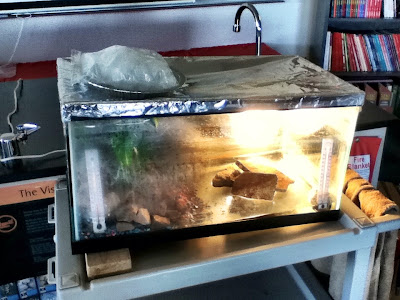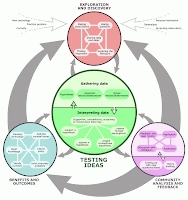Learning about the Earth as a system provides a wide range of opportunities for students to explore various sets of data to better understand the individual components — the atmosphere, the hydrosphere, the geosphere, the biosphere — and how they are interconnected. Throughout our study of Earth science, I give students multiple occasions to interpret, analyze, and evaluate various Earth system data. Over the years, I've built up a collection of simple, useful datasets for students to manipulate using graphing software such as Microsoft Excel,
Create A Graph, or Google Spreadsheet. Here is a sampling of some of these data.
The Atmosphere
Each year, we begin our study of the Earth system within the atmosphere—the gaseous envelope surrounding our planet which has evolved from and interacts with the other "spheres" of the Earth system. Investigating the composition of Earth's atmosphere is thus a logical first step in our data exploration.
Composition of Earth's Atmosphere
Data source: Wallace, J.M. and Hobbs, P.V., 1977, Atmospheric Science—An Introductory Survey
| Compound |
Percent |
| Nitrogen |
78.08 |
| Oxygen |
20.95 |
| Argon |
0.93 |
| Trace Gases |
0.04 |
It is useful to refer back to this set of data often during our climate studies, reminding students that the tiny fraction of trace gases are responsible for the greenhouse effect and instrumental in maintaining the balance in Earth's energy budget.
The Hydrosphere
As we move from the atmosphere to the hydrosphere, students explore how water is distributed across our planet as well as examine the composition of ocean water. When examining global water distribution, it is useful to have students consider how much of this water is readily available for daily human use. Additionally, this set of data provides an opportunity for students to learn how to create "pie-of-pie" graphs to best show data that has a large range of values.
Global Water Distribution
Data source: Gleick, P. H., 1996, Water resources. In Encyclopedia of Climate and Weather, ed. by S. H. Schneider, Oxford
University Press, New York, vol. 2, pp. 817-823
| Water Source |
Percent |
| Oceans, Seas, and Bays |
96.5 |
| Ice Caps, Glaciers, and Permanent Snow |
1.74 |
| Groundwater (fresh) |
0.76 |
| Groundwater (saline) |
0.94 |
| Soil Moisture |
0.001 |
| Ground Ice and Permafrost |
0.022 |
| Lakes (fresh) |
0.007 |
| Lakes (saline) |
0.006 |
| Atmosphere |
0.001 |
| Swamp Water |
0.0008 |
| Rivers |
0.0002 |
| Biological Water |
0.0001 |
"Have you ever had a mouthful of ocean water?" is a great question to ask students when introducing the next set of data. It elicits an immediate "Ewww!" response and primes students to think about the compounds contained in that mouthful of water and how they got there.
Composition of Ocean Water
Data source: National Science Teachers Association, 1992, Project Earth Science, Physical Oceanography
| Element |
Percent |
| Oxygen |
85.7 |
| Hydrogen |
10.8 |
| Chlorine |
1.9 |
| Sodium |
1.05 |
| Magnesium |
0.135 |
| Sulfur |
0.0885 |
| Calcium |
0.04 |
| Potassium |
0.038 |
| Bromine |
0.0065 |
| Carbon |
0.0028 |
| Other |
0.001 |
The Geosphere
When we transition to our studies of the geosphere, students take a look at data comprising the Earth's crust. The composition of Earth's crust shows many commonalities with the composition of ocean water data above. It is useful to have students compare and contrast the two sets of data. It is quite a challenging discussion when students are asked to explain how the Earth's crust can be nearly 50% oxygen; it helps reinforce the meaning of "compound."
Composition of Earth's Crust
Data source: Glencoe Earth Science, 1999
| Element |
Percent |
| Oxygen |
46.6 |
| Silicon |
27.7 |
| Aluminum |
8.1 |
| Iron |
5.0 |
| Calcium |
3.6 |
| Sodium |
2.8 |
| Potassium |
2.6 |
| Magnesium |
2.1 |
| Other |
1.5 |
The Solar System
Finally, as we move from the safety of our home planet and journey into the rest of the solar system, it is interesting to ponder the composition of the solar system itself. Once again, it is useful to compare and contrast the similarities and differences among the various sets of data ("What's up with all that hydrogen?"). It is also interesting to ponder how knowledge of Earth's composition can help scientists understand and make sense of the compositions of other objects in our solar system.
Composition of the Solar System
| Element |
Percent |
| Hydrogen |
91.04 |
| Helium |
8.81 |
| Oxygen |
0.08 |
| Carbon |
0.03 |
| Neon |
0.01 |
| Nitrogen |
0.01 |
| Magnesium |
0.004 |
| Silicon |
0.003 |
| Iron |
0.003 |
With an endless variety of Earth system data available, students have many opportunities to deeply engage in scientific analysis and interpretation as well as develop an appreciation for the Earth as an interconnected system. If you use other interesting datasets, please feel free to share them in the comments...
























